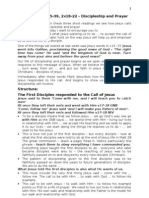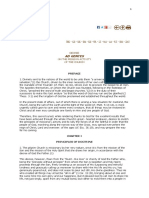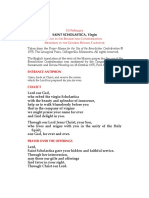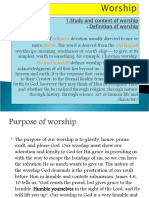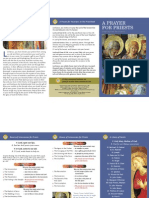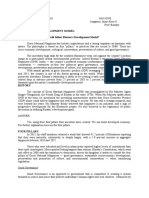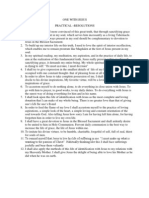0 ratings0% found this document useful (0 votes)
140 viewsChristians: What Is Advent?
Christians: What Is Advent?
Uploaded by
Jamie Rose AragonesAdvent is a season of preparation that marks the church waiting in prayerful expectation for Jesus Christ's return in glory. While it originally focused on preparation for Epiphany and was a time of penance, the season later became linked to anticipation of both Christ's first coming at Christmas and his second coming. Today Advent lasts four Sundays before Christmas and represents the church's present situation awaiting Christ's return, looking back to his first coming and forward to his second.
Copyright:
© All Rights Reserved
Available Formats
Download as DOCX, PDF, TXT or read online from Scribd
Christians: What Is Advent?
Christians: What Is Advent?
Uploaded by
Jamie Rose Aragones0 ratings0% found this document useful (0 votes)
140 views20 pagesAdvent is a season of preparation that marks the church waiting in prayerful expectation for Jesus Christ's return in glory. While it originally focused on preparation for Epiphany and was a time of penance, the season later became linked to anticipation of both Christ's first coming at Christmas and his second coming. Today Advent lasts four Sundays before Christmas and represents the church's present situation awaiting Christ's return, looking back to his first coming and forward to his second.
Original Title
Advent
Copyright
© © All Rights Reserved
Available Formats
DOCX, PDF, TXT or read online from Scribd
Share this document
Did you find this document useful?
Is this content inappropriate?
Advent is a season of preparation that marks the church waiting in prayerful expectation for Jesus Christ's return in glory. While it originally focused on preparation for Epiphany and was a time of penance, the season later became linked to anticipation of both Christ's first coming at Christmas and his second coming. Today Advent lasts four Sundays before Christmas and represents the church's present situation awaiting Christ's return, looking back to his first coming and forward to his second.
Copyright:
© All Rights Reserved
Available Formats
Download as DOCX, PDF, TXT or read online from Scribd
Download as docx, pdf, or txt
0 ratings0% found this document useful (0 votes)
140 views20 pagesChristians: What Is Advent?
Christians: What Is Advent?
Uploaded by
Jamie Rose AragonesAdvent is a season of preparation that marks the church waiting in prayerful expectation for Jesus Christ's return in glory. While it originally focused on preparation for Epiphany and was a time of penance, the season later became linked to anticipation of both Christ's first coming at Christmas and his second coming. Today Advent lasts four Sundays before Christmas and represents the church's present situation awaiting Christ's return, looking back to his first coming and forward to his second.
Copyright:
© All Rights Reserved
Available Formats
Download as DOCX, PDF, TXT or read online from Scribd
Download as docx, pdf, or txt
You are on page 1of 20
What is Advent?
For many Christians unfamiliar with the liturgical
year, there may be some confusion surrounding the
meaning of the Advent season. Some people may
know that the Advent season focuses on
expectation and think that it serves as an
anticipation of Christ’s birth in the season leading
up to Christmas. This is part of the story, but
there’s more to Advent.
The History of Advent
The word “Advent” is derived from the Latin
word adventus, meaning “coming,” which is a
translation of the Greek word parousia. Scholars
th th
believe that during the 4 and 5 centuries in
Spain and Gaul, Advent was a season of preparation
for the baptism of new Christians at the January
feast of Epiphany, the celebration of God’s
incarnation represented by the visit of the Magi to
the baby Jesus (Matthew 2:1), his baptism in the
Jordan River by John the Baptist (John 1:29), and
his first miracle at Cana (John 2:1). During this
season of preparation, Christians would spend 40
days in penance, prayer, and fasting to prepare for
this celebration; originally, there was little
connection between Advent and Christmas.
th
By the 6 century, however, Roman Christians had
tied Advent to the coming of Christ. But the
“coming” they had in mind was not Christ’s first
coming in the manger in Bethlehem, but his second
coming in the clouds as the judge of the world. It
was not until the Middle Ages that the Advent
season was explicitly linked to Christ’s first coming
at Christmas.
Advent Today
Today, the Advent season lasts for four Sundays
leading up to Christmas. At that time, the new
Christian year begins with the twelve-day
celebration of Christmastide, which lasts from
Christmas Eve until Epiphany on January 6.
(Advent begins on the Sunday that falls between
November 27th and December 3rd each year.)
Advent symbolizes the present situation of the
church in these “last days” (Acts 2:17, Hebrews
1:2), as God’s people wait for the return of Christ
in glory to consummate his eternal kingdom. The
church is in a similar situation to Israel at the end
of the Old Testament: in exile, waiting and hoping
in prayerful expectation for the coming of the
Messiah. Israel looked back to God’s past gracious
actions on their behalf in leading them out of
Egypt in the Exodus, and on this basis they called
for God once again to act for them. In the same
way, the church, during Advent, looks back upon
Christ’s coming in celebration while at the same
time looking forward in eager anticipation to the
coming of Christ’s kingdom when he returns for his
people. In this light, the Advent hymn “O Come, O
Come, Emmanuel” perfectly represents the
church’s cry during the Advent season:
O come, O come, Emmanuel,
And ransom captive Israel,
That mourns in lonely exile here
Until the Son of God appears.
Rejoice! Rejoice!
Emmanuel shall come to thee, O Israel.
While Israel would have sung the song in
expectation of Christ’s first coming, the church
now sings the song in commemoration of that first
coming and in expectation of the second coming in
the future.
Advent Liturgy and Practice
To balance the two elements of remembrance and
anticipation, the first two Sundays in Advent
th
(through December 16 ) look forward to Christ’s
second coming, and the last two Sundays
th th
(December 17 – 24 ) look backward to remember
Christ’s first coming. Over the course of the four
weeks, Scripture readings move from passages
about Christ’s return in judgment, to Old
Testament passages about the expectation of the
coming Messiah, to New Testament passages about
the announcements of Christ’s arrival by John the
Baptist and the Angels.
While it is difficult to keep in mind in the midst of
holiday celebrations, shopping, lights and
decorations, and joyful carols, Advent is intended
to be a season of fasting, much like Lent, and
there are a variety of ways that this time of
mourning works itself out in the season. Reflection
on the violence and evil in the world cause us to cry
out to God to make things right—to put death’s
dark shadows to flight. Our exile in the present
makes us look forward to our future Exodus. And
our own sinfulness and need for grace leads us to
pray for the Holy Spirit to renew his work in
conforming us into the image of Christ.
One catechism describes Advent spirituality
beautifully: “When the Church celebrates the
liturgy of Advent each year, she makes present
this ancient expectancy of the Messiah, for by
sharing in the long preparation for the Savior’s
first coming, the faithful renew their ardent
desire for his second coming. By celebrating the
precursor’s birth and martyrdom, the Church
unites herself to his desire: ‘He must increase, but
I must decrease.’”
Advent and the Christian Life
While Advent is certainly a time of celebration and
anticipation of Christ’s birth, it is more than that.
It is only in the shadow of Advent that the miracle
of Christmas can be fully understood and
appreciated; and it is only in the light of Christmas
that the Christian life makes any sense. It is
between the fulfilled promise of Christ’s first
coming and the yet-to-be-fulfilled promise of his
second coming that Karl Barth penned these
words: “Unfulfilled and fulfilled promise are
related to each other, as are dawn and sunrise.
Both are promise and in fact the same promise. If
anywhere at all, then it is precisely in the light of
the coming of Christ that faith has become Advent
faith, the expectation of future revelation. But
faith knows for whom and for what it is waiting. It
is fulfilled faith because it lays hold on the
fulfilled promise.”
The promise for Israel and the promise for the
church is Jesus Christ; he has come, and he will
come again. This is the essence of Advent.
You might also like
- The Answer Is Jesus PDFDocument1 pageThe Answer Is Jesus PDFdalenielriveraNo ratings yet
- Albert Benjamin SimpsonDocument5 pagesAlbert Benjamin SimpsonvaniamelissaNo ratings yet
- By Hillsong Worship: Full Lyrics: This I BelieveDocument2 pagesBy Hillsong Worship: Full Lyrics: This I BelieveLouie Jay PoligratesNo ratings yet
- Handbook of The Lay PriestDocument63 pagesHandbook of The Lay PriestJoe PughNo ratings yet
- Christology of John WesleyDocument25 pagesChristology of John WesleyNjono SlametNo ratings yet
- Lesson 03 - Eternal SecurityDocument11 pagesLesson 03 - Eternal Securitygraceo_1No ratings yet
- What Is Advent?Document2 pagesWhat Is Advent?Elaine YapNo ratings yet
- Occasion: Resurrection and Communion Sunday Worship ServiceDocument15 pagesOccasion: Resurrection and Communion Sunday Worship ServiceNicole Velasquez SaliNo ratings yet
- Sermon Series Ideas GuideDocument9 pagesSermon Series Ideas GuideSarah KodeshNo ratings yet
- The Sacraments of HealingDocument4 pagesThe Sacraments of HealingJohn MarkNo ratings yet
- My Reflections On Vita ConsecrataDocument6 pagesMy Reflections On Vita ConsecrataKim Larson BaltazarNo ratings yet
- Holding Hands and Orans Position During The Our FatherDocument64 pagesHolding Hands and Orans Position During The Our FatherFrancis LoboNo ratings yet
- Holy Eucharist: Source and Summit of The Christian LifeDocument21 pagesHoly Eucharist: Source and Summit of The Christian LifeJoedy Mae Bitara MangampoNo ratings yet
- Chapter 2 - PrayerDocument16 pagesChapter 2 - Prayeroldaltarboy7137No ratings yet
- Communion Service Daily PDFDocument2 pagesCommunion Service Daily PDFJuanmiguel Ocampo Dion SchpNo ratings yet
- Common PrayerDocument99 pagesCommon PrayerJosep RosselloNo ratings yet
- 2011 Advent ReflectionsDocument18 pages2011 Advent ReflectionsPrecious Blood SpiritualityNo ratings yet
- Order of Service 29.11.2020Document12 pagesOrder of Service 29.11.2020Niall James SloaneNo ratings yet
- Ministry and SacramentsDocument4 pagesMinistry and SacramentsEverything newNo ratings yet
- Sample Responses For BaptismDocument4 pagesSample Responses For Baptismapi-243705673No ratings yet
- Mark 1 Discipleship and PrayerDocument4 pagesMark 1 Discipleship and PrayerMichael FormanNo ratings yet
- Mark 10 35-45Document16 pagesMark 10 35-45Ariel Doroteo Destora100% (1)
- The Christmas Wreath Advent Week OneDocument15 pagesThe Christmas Wreath Advent Week OnePastor JeanneNo ratings yet
- Church EthicsDocument2 pagesChurch EthicsKim John100% (1)
- Advent Prayer Service Call To PrayerDocument4 pagesAdvent Prayer Service Call To PrayerThadeus MendozaNo ratings yet
- Youcat PresentationDocument29 pagesYoucat PresentationLeon GuintoNo ratings yet
- PrayerDocument20 pagesPrayerZosima Caniga GabuleNo ratings yet
- 2014 Advent Devotionals-WebDocument28 pages2014 Advent Devotionals-Webapi-256506185No ratings yet
- Family-Centered Catechesis PDFDocument12 pagesFamily-Centered Catechesis PDFtimNo ratings yet
- Ad GentesDocument29 pagesAd GentesGiGi AdvinculaNo ratings yet
- Common Catholic Questions & AnswerDocument4 pagesCommon Catholic Questions & AnswerBryan PielNo ratings yet
- 05 - 25 - 22 Youth Missions LessonDocument9 pages05 - 25 - 22 Youth Missions LessonClaytonNo ratings yet
- Epiphany of The LordDocument53 pagesEpiphany of The LordJonah ReyesNo ratings yet
- Lesson-10the Church History - Early Church, DiscensionsDocument14 pagesLesson-10the Church History - Early Church, DiscensionsEmmalyn Patindol100% (1)
- Exploring Isaiah HandoutDocument59 pagesExploring Isaiah Handoutnani100% (1)
- Infographic - Dialogue With CultureDocument2 pagesInfographic - Dialogue With CultureRUSHELLE INTIA100% (1)
- LIberative Solidarity - Contemporary PerspeDocument249 pagesLIberative Solidarity - Contemporary PerspeSigilfredo Patiño CoronadoNo ratings yet
- Priesthood NotesDocument18 pagesPriesthood NotesChristian Anthony Malingin TanNo ratings yet
- Bbandonata: Lent: Prayer, FasDocument4 pagesBbandonata: Lent: Prayer, FasCynch G. PelagoNo ratings yet
- Liturgical Propers For The Feast of Saint ScholasticaDocument2 pagesLiturgical Propers For The Feast of Saint ScholasticaAaron J. R. VelosoNo ratings yet
- Constitution On The Sacred LiturgyDocument2 pagesConstitution On The Sacred LiturgyDarryl Reyes100% (1)
- Eccles I OlogyDocument46 pagesEccles I OlogyKingsley ObinnaNo ratings yet
- Lesson Plans Ass 2bDocument9 pagesLesson Plans Ass 2bapi-325014978No ratings yet
- Have Sacraments ChangedDocument5 pagesHave Sacraments Changedherbert23No ratings yet
- What Is LentDocument3 pagesWhat Is LentMie ArmsNo ratings yet
- Religious Deities Old English Evelyn Underhill: Worthscipe Worthiness Worth-ShipDocument33 pagesReligious Deities Old English Evelyn Underhill: Worthscipe Worthiness Worth-ShipSophy Alex100% (1)
- The Sanctifying Function of The Church-D'AuriaDocument10 pagesThe Sanctifying Function of The Church-D'AuriaRuban LouisNo ratings yet
- WBAY Holiday Programming - 2022Document3 pagesWBAY Holiday Programming - 2022Ted MillerNo ratings yet
- Passion, Death & ResurrectionDocument191 pagesPassion, Death & ResurrectionNoremacmNo ratings yet
- Sacrament of Reconciliation 1Document16 pagesSacrament of Reconciliation 1Gerald Sucalit GabasNo ratings yet
- Moral Teachings in CatholicDocument23 pagesMoral Teachings in CatholicBrenda Macanlalay AsuncionNo ratings yet
- 29 The Third CommandmentDocument11 pages29 The Third CommandmentSaturday Doctrine ClassNo ratings yet
- 13semconf House Blessing PDFDocument2 pages13semconf House Blessing PDFLeumas Somar OnarresNo ratings yet
- Catholic EschatologyDocument21 pagesCatholic Eschatologyjanetolojede662100% (1)
- Camp Meeting 2023 Booklet (Final) PDFDocument12 pagesCamp Meeting 2023 Booklet (Final) PDFjndayizigiye17No ratings yet
- GAFCON 2018 Letter To The Churches - FinalDocument8 pagesGAFCON 2018 Letter To The Churches - FinalGeorge CongerNo ratings yet
- GIRM Cross ReferencesDocument21 pagesGIRM Cross ReferencesDarryl ReyesNo ratings yet
- Prayer of Rosary For PriestsDocument2 pagesPrayer of Rosary For PrieststhepillquillNo ratings yet
- Ysts - Lesson 969 - The Danger of LukewarmnessDocument3 pagesYsts - Lesson 969 - The Danger of LukewarmnessboatcomNo ratings yet
- Emerging Conversations on Theofiliation: Essays in Honour of Archbishop Anthony J. V. ObinnaFrom EverandEmerging Conversations on Theofiliation: Essays in Honour of Archbishop Anthony J. V. ObinnaNo ratings yet
- CH16 Hbo ReportDocument42 pagesCH16 Hbo ReportJamie Rose AragonesNo ratings yet
- Leadership: Butial, Ferlyn T. Sarmiento, Sherry AnnDocument32 pagesLeadership: Butial, Ferlyn T. Sarmiento, Sherry AnnJamie Rose AragonesNo ratings yet
- Power and Politics: Bsa-3A Michaela A. Revilleza John Carlo M. SequenaDocument28 pagesPower and Politics: Bsa-3A Michaela A. Revilleza John Carlo M. SequenaJamie Rose AragonesNo ratings yet
- Bar Review Corp Law Part IVDocument93 pagesBar Review Corp Law Part IVJamie Rose AragonesNo ratings yet
- Bar Review Corp Law Part IiDocument78 pagesBar Review Corp Law Part IiJamie Rose AragonesNo ratings yet
- Bar Review Corp Law Part IiiDocument80 pagesBar Review Corp Law Part IiiJamie Rose AragonesNo ratings yet
- FINAL., Contemporary Project ReseachDocument13 pagesFINAL., Contemporary Project ReseachJamie Rose AragonesNo ratings yet
- RESEARCH Sarmiento&MacatangcopDocument17 pagesRESEARCH Sarmiento&MacatangcopJamie Rose AragonesNo ratings yet
- Meeting Aug 15 ContemporaryDocument1 pageMeeting Aug 15 ContemporaryJamie Rose AragonesNo ratings yet
- Business Law Reviewer FinalsDocument34 pagesBusiness Law Reviewer FinalsJamie Rose AragonesNo ratings yet
- Business Ethics MidtermDocument12 pagesBusiness Ethics MidtermJamie Rose AragonesNo ratings yet
- Student Number 1Document1 pageStudent Number 1Jamie Rose AragonesNo ratings yet
- Chapter I Mcdonaldization: DefinitonDocument7 pagesChapter I Mcdonaldization: DefinitonJamie Rose AragonesNo ratings yet
- AUDITING FINAL EXAM 90 Items Feb. 2021 MargieDocument11 pagesAUDITING FINAL EXAM 90 Items Feb. 2021 MargieJamie Rose AragonesNo ratings yet
- GEC 103 Contemporary World AssignmentDocument11 pagesGEC 103 Contemporary World AssignmentJamie Rose AragonesNo ratings yet
- Contemporary Rachel GesmundoDocument5 pagesContemporary Rachel GesmundoJamie Rose AragonesNo ratings yet
- Auditing Theory SalosagcolDocument4 pagesAuditing Theory SalosagcolYuki CrossNo ratings yet
- HRE2O1 Day 1Document3 pagesHRE2O1 Day 1Sana SethNo ratings yet
- The Gospel at Home: Family GuideDocument1 pageThe Gospel at Home: Family Guideapi-242799322No ratings yet
- How To Say Rosary - EnglishDocument2 pagesHow To Say Rosary - EnglishjunglexcatNo ratings yet
- What Is Christmas According To The BibleDocument1 pageWhat Is Christmas According To The BibleZeeipiNo ratings yet
- Understanding The Ford Crisis in The Pages of SpectrumDocument16 pagesUnderstanding The Ford Crisis in The Pages of SpectrumKessia Reyne Bennett100% (1)
- 28 February 2023 - Funeral Mass SongsDocument2 pages28 February 2023 - Funeral Mass SongsJovan ChuaNo ratings yet
- There's Nothing That Our God Can't Do-chords-CDocument2 pagesThere's Nothing That Our God Can't Do-chords-CkevinjkanagarajNo ratings yet
- Elective Assignment VivinDocument4 pagesElective Assignment VivinVivin RodrhicsNo ratings yet
- Revolution Is Always WrongDocument3 pagesRevolution Is Always WrongStThomasAquinas100% (1)
- Building A Christian HomeDocument53 pagesBuilding A Christian HomeMarie Ysabel PanagsaganNo ratings yet
- One With Jesus - Practical ResolutionsDocument1 pageOne With Jesus - Practical ResolutionschapertraperNo ratings yet
- Evidence of GraceDocument6 pagesEvidence of Gracehezekia esperonNo ratings yet
- Q4 2024 - LESSON 11Document1 pageQ4 2024 - LESSON 11yonie eranistaNo ratings yet
- HeavenDocument29 pagesHeavenUCHOOSE2861No ratings yet
- 950 - Behold Among MenDocument1 page950 - Behold Among MenJohn AwodolaNo ratings yet
- Stronger - Hillsong Worship Lyrics and Chords Worship TogetherDocument3 pagesStronger - Hillsong Worship Lyrics and Chords Worship TogetherLOrie JOhnNo ratings yet
- 126-132 The Personal DimensionDocument8 pages126-132 The Personal Dimensionalma moraNo ratings yet
- Necrological Service: Maria Adtoon BalateroDocument6 pagesNecrological Service: Maria Adtoon BalateroJohn Russell MoralesNo ratings yet
- 12 MarkersDocument1 page12 MarkersSonny NeilsonNo ratings yet
- The Battle of ArmageddonDocument2 pagesThe Battle of ArmageddonJoshua PerezNo ratings yet
- Patriarch Address WCC MeetingDocument5 pagesPatriarch Address WCC MeetingthriskeftikaNo ratings yet
- We Are Stewards of The Most High GodDocument3 pagesWe Are Stewards of The Most High GodBawonda Isaiah100% (1)
- King of KingsDocument2 pagesKing of KingsRachel SungNo ratings yet
- 325, 381 - Nicene CreedDocument1 page325, 381 - Nicene CreedmugofrussiaNo ratings yet
- The Sin Against The Holy SpiritDocument16 pagesThe Sin Against The Holy SpiritBill EnsslenNo ratings yet
- The Spirit - EnlivenedDocument1 pageThe Spirit - EnlivenedVerxNo ratings yet




















